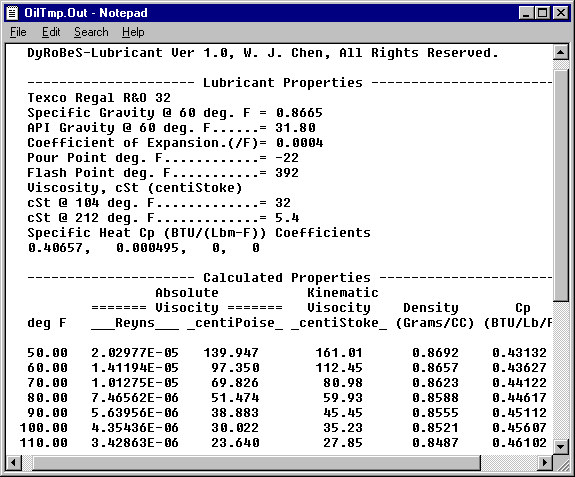
An accurate lubricant dynamic viscosity is essential to the calculation of bearing performance. The basic properties of a number of commonly used lubricants are collected and stored in a library. User can always add new lubricants into the library or edit the existing lubricants by selecting Edit Lubricant Library. The Lubricant Properties option tabulates the lubricant properties (viscosity, density, specific heat), for a range of temperatures specified in the dialog box. The Lubricant Chart option displays the lubricant properties for up to 3 different lubricants in a chart for comparison proposes.

Edit Lubricant Library
This function allows you to edit your own lubricants from the library and also to review the existing lubricants data in the library. Input parameters are:
Lubricant
Select the lubricant that you like to edit.
Title
This title will become the lubricant identification after the data is saved.
Specific gravity @ 60 oF (15.6 oC)
Very often oAPI is used to describe the specific gravity. The API gravity and the specific gravity at 60 oF are related by the following equation:

Viscosity (centiStoke) at two temperature points
The viscosities (cSt) at 100 oF and 210 oF (or at 40 oC and 100 oC) are commonly published by the lubricant suppliers. ASTM viscosity-temperature relationship is used to calculate the viscosity at any given temperature.
Pour and flash points
These data are entered for reference only.
Coefficient of expansion
If you do not know the coefficient of expansion, then enter zero in the input. The program will estimate it based on the specific gravity and data table provided in the Handbook of Lubrication.
Coefficients for specific heat
The specific heat is a function of temperature and specific gravity. If you do not know the coefficients for specific heat, then enter zeros. The program will estimate them based on the data provided in the Publication No. 97 from Bureau of Standards.

Lubricant Properties
This function tabulates the lubricant properties (viscosity, density, specific heat) for a range of temperatures specified in the dialog box. The results are displayed immediately on the screen. You can view, print, and save the file.


Lubricant Charts
This function allows you to compare the lubricant properties for up to 3 different lubricants. The graphic results are displayed immediately on the screen. The first default graph is the dynamic viscosity vs. temperature. You can choose Settings under the Options menu to select the desired graph data (Reyn, centiPoise, centiStoke, Specific Gravity, Weight Density, and Specific Heat), plot type (Linear-Linear, Linear-Log, Log-Log), and manual scaling the axes.




Copyright © 2014-2017